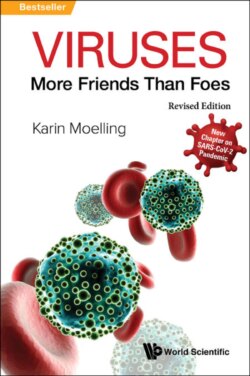Читать книгу Viruses: More Friends Than Foes (Revised Edition) - Karin Moelling - Страница 8
На сайте Литреса книга снята с продажи.
“I got a cold”
ОглавлениеThis is known to everybody; every winter we get seasonal flu, with fever, coughing, sneezing, aching joints and headache — often all at the same time. We should use some protection against sneezing, but hardly anyone still has a real handkerchief anymore. Paper tissues need to be used correctly — they should not go into a wastepaper basket, but into a bucket with a lid. Even on television it is now being demonstrated how should bend one’s arm and sneeze into the crook of the elbow.
People should stay at home; otherwise, in no time at all, colleagues and people working on the same floor are going to become infected. In Switzerland I have always tried to avoid handshaking in clinical settings. However, as it is the western style of greeting and welcoming, but I was not allowed to omit the handshake, as it would have seemed unwelcoming and unfriendly. Yet now, handshaking has been abolished completely. Most respiratory diseases are transmitted by droplet infections, which can cover a distance of 50 cm and may transport 105 virus particles in a single sneeze, and can be passed on via hands to others.
“Getting a cold” is an apt description of how one can fall ill. Viruses become activated if our environment changes: a cold wind, wet clothes or wet shoes all affect our well-being, and they activate viruses. We live with the world of microorganisms in a balanced ecosystem, and we have an immune system that keeps viruses in check. Viruses do not have to seek us out: they are there all the time in our nose or throat, and all they need is the right conditions to make them virulent, which means start replicating. Dry air inside heated rooms, or outside frost, can increase viral activation and replication. Adults get two to four such infections each winter season, and children even more, with normally much higher amounts of viruses. They can easily infect their grandparents, whose immunity is reduced by ageing.
Viruses select short distances. These are given in public transport, at mass events, in shopping malls or in schools.
So far, this has been a description of any seasonal respiratory disease, such as occurs by viral infection in the autumn or the winter.
The infection can be much worse if the cause is the real influenza virus. This is a very severe cold which starts quite abruptly with very high fever, pain and loss of consciousness. People suffering from it are too weak to get up.
Another virus, different again, is the new coronavirus. It is called SARS-coronavirus-2 or CoV-2 for short. The disease is called COVID-19, an abbreviation of “Corona-Virus Infectious Disease from the year 2019” (the year when it first occurred). The term SARS refers to the first coronavirus, which went on the rampage in 2003, unleashing the first coronavirus pandemic that caused a “severe acute respiratory syndrome”, the symptoms of the atypical lung inflammation that it induced. Then there is a third member in this group of dangerous coronaviruses; it causes the “Middle East Respiratory Syndrome” (MERS) and first showed up in Saudi Arabia in 2012.
